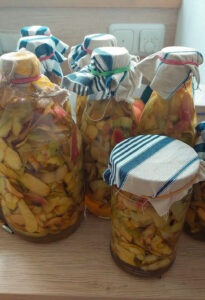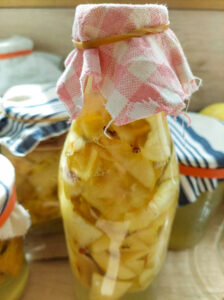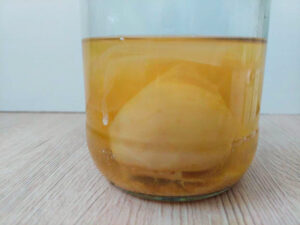.
If you, like me, pickle a lot of vegetables, you need a good deal of apple vinegar. Instead of buying it, however, why not try your hand at making it by yourself – from scraps! It’s so easy, that you’ll wonder why you didn’t do it earlier and never will buy a drop of apple vinegar again. All you need is apple scraps that is peels and cores (for example from making apple sauce or dry-canning apples), water, sugar and a bit of raw apple vinegar to start. As containers you’ll need sufficiently large sterile bottles or jars as well as some cloths to cover the jars
But before we start, let’s take a quick look at how vinegar is made.
Step 1: Sugar becomes alcohol
The first step to making apple vinegar is the production of apple wine. Natural yeasts transform the sugar from the apples plus the sugar we add into alcohol. You can see that by the formation of white foam on the surface. It’s also possible that after a few days, a white layer forms on the surface. That’s kahm yeast and it’s harmless.
When, after some time, the acid content in the liquid rises, kahm (and other) yeast(s) disappear.
Step 2: Alcohol becomes vinegar
As soon as the first alcohol has formed, acetic acid bacteria also start to work. They are naturally in the air and on the fruits and need alcohol and oxygen to multiply. For this reason, it’s essential that you only cover the jars with a cloth because without oxygen the acetic acid bacteria cannot work.
The alcohol is now fermented to acetic acid. If you want to learn more about how fermentation works, this article is just the thing you need:
How to make apple vinegar from scraps
Prepare your jars by washing them and the lids in hot water or the dishwasher and then let them dry.
Before processing your apples, wash them thoroughly in the sink to remove any dirt. Now peel and quarter them (depending on what you want to do with those apples) and remove the core. Cut off any rotten parts. Only unspoiled and healthy peels and cores can be used for making vinegar.
When chopping apples, I usually have three bowls at hand: one for the apple quarters to be processed, one for the “good” apple peels and cores and one for the rotten parts to be thrown away.
Put the peels and cores into a one-litre glass bottle until it’s about ¾ full. Add half a cup of sugar, and half a cup of apple vinegar as a starter and fill the bottle up with water. Stir or shake the mixture until the sugar has dissolved.
Don’t close the bottle with a lid as we need oxygen to make vinegar. Instead, put a clean piece of cloth on the bottle opening and fix it with a rubber band. That way, the liquid is exposed to oxygen, but no fruit flies or dirt can get into it.

Put the bottle in a warm, dark place (no direct sunlight) and let it sit for about 10 – 14 days. After a few days, you’ll see tiny bubbles forming.

After a few days, bubbles start to form
Sometimes, the mixture builds foam and may even bubble over the rim. If a thin white spread forms on the surface that destroys when you stir it slightly, that’s no reason to worry. It’s kahm yeast and will neither affect the process nor the taste. Around day 6 it’ll start to smell of vinegar.
After about 10 – 14 days, strain the liquid through a colander into a clean glass bottle. Make sure to squeeze out any residual liquid from the peels. If you have, you can add a vinegar mother to your fresh vinegar. This will help it to mature.
Put a fresh clean cloth on the opening and fix it with a rubber band. Let the vinegar mature in a cool, dark place for about six months. During this time, a mother of vinegar might form which is a great sign that everything’s going well! Taste your vinegar after six months. If it’s to your liking and a vinegar mother has formed, decant it into a fresh bottle. Carefully put the vinegar mother into a separate jar and fill it up with enough vinegar to cover it completely. You may use it as a starter for the next vinegar.

Homegrown jellyfish, a.k.a. mother of vinegar
Other fruit vinegars
I’ve also tried making vinegar from pear and quince scraps and it worked out very well. The pear and quince vinegar took a bit longer to mature (about 8 – 12 months) but the wait was absolutely worth it! Both vinegars tasted deliciously fruity and relatively mild and they add an interesting flavour to fruit salads. Pear and quince vinegar are also marvellous in a vinaigrette for autumn salads like lamb’s ear and chicory with pears, grapes and walnuts.

0 Comments